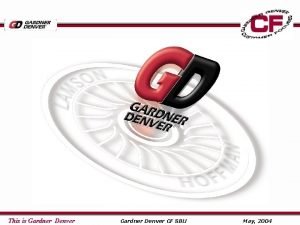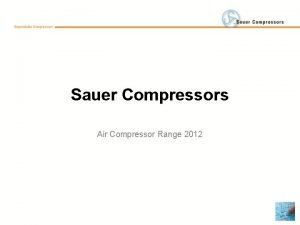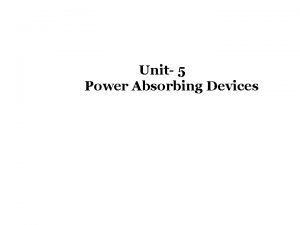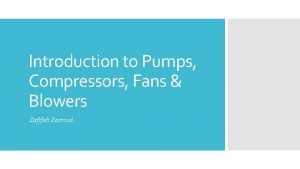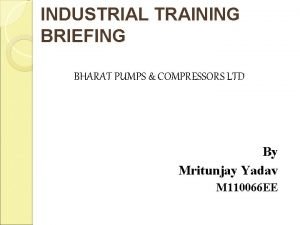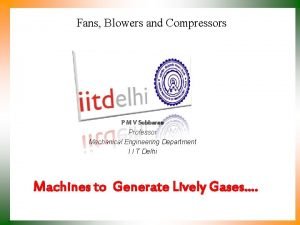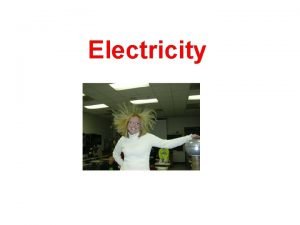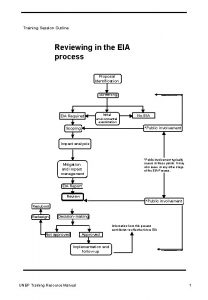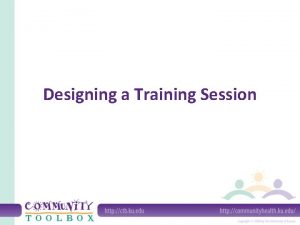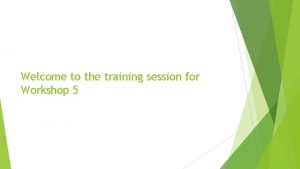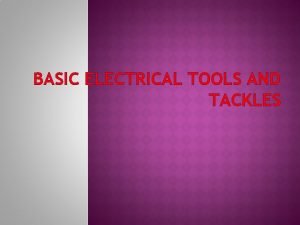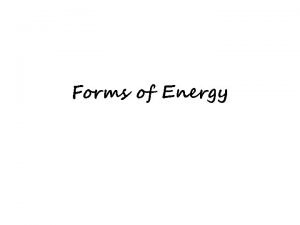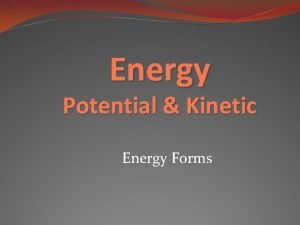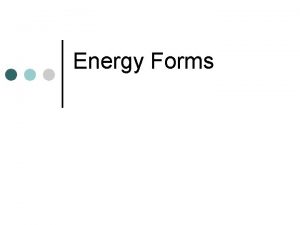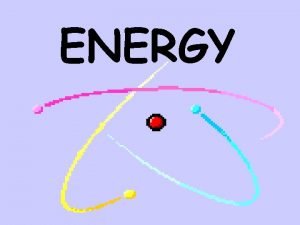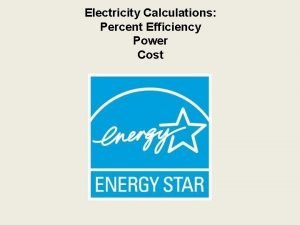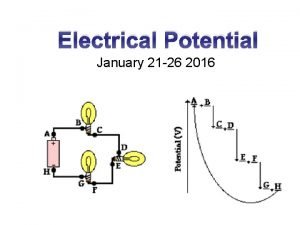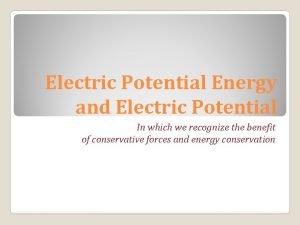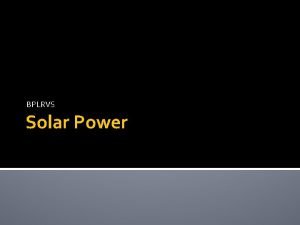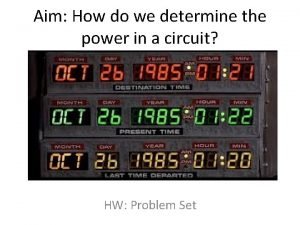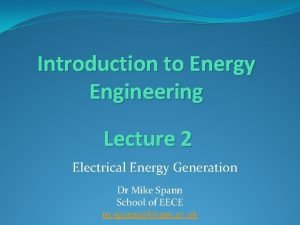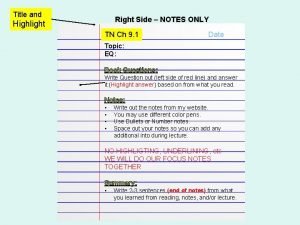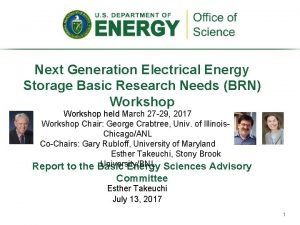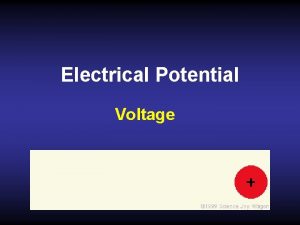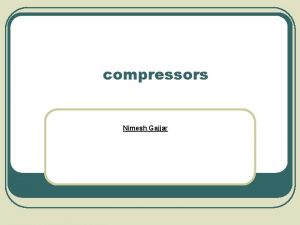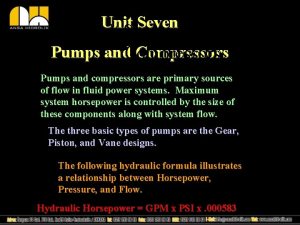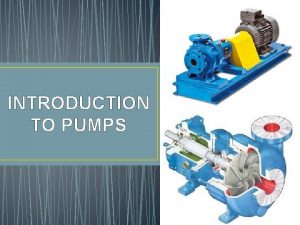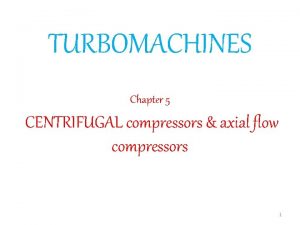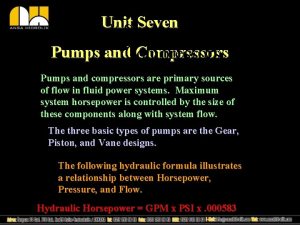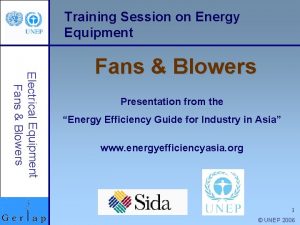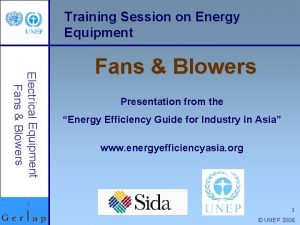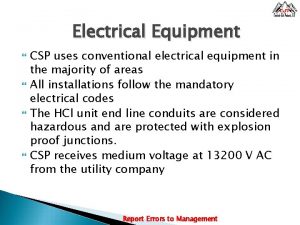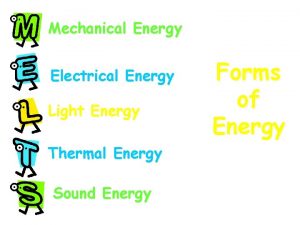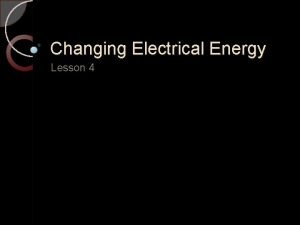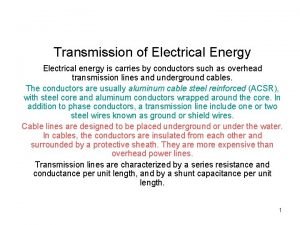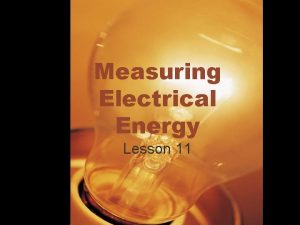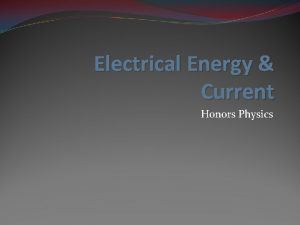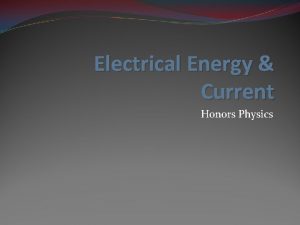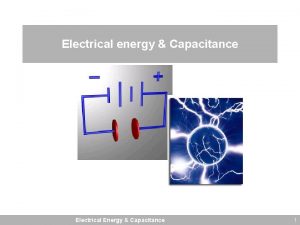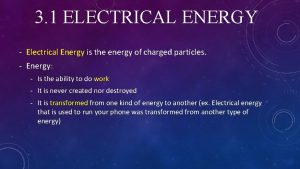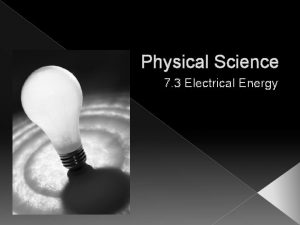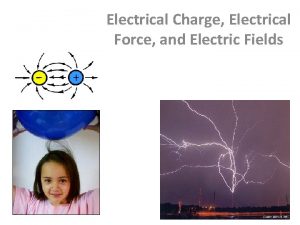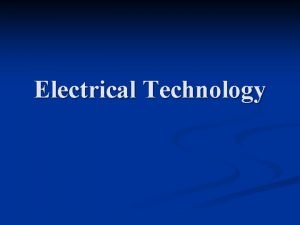Training Session on Energy Equipment Electrical Equipment Compressors



































- Slides: 35

Training Session on Energy Equipment Electrical Equipment/ Compressors & Compressed Air Systems Presentation from the “Energy Efficiency Guide for Industry in Asia” www. energyefficiencyasia. org 1 © UNEP 2006

Training Agenda: Compressor Electrical Equipment/ Compressors Introduction Types of compressors Assessment of compressors and compressed air systems Energy efficiency opportunities 2 © UNEP 2006

Introduction Significant Inefficiencies Electrical Equipment/ Compressors • Compressors: 5 to > 50, 000 hp • 70 – 90% of compressed air is lost (Mc. Kane and Medaris, 2003) 3 © UNEP 2006

Introduction Electrical Equipment/ Compressors Benefits of managed system • Electricity savings: 20 – 50% • Maintenance reduced, downtime decreased, production increased and product quality improved (e. Compressed. Air) 4 © UNEP 2006

Introduction Electrical Equipment/ Compressors Main Components in Compressed Air Systems • Intake air filters • Inter-stage coolers • After coolers • Air dryers • Moisture drain traps • Receivers 5 © UNEP 2006

Training Agenda: Compressor Electrical Equipment/ Compressors Introduction Types of compressors Assessment of compressors and compressed air systems Energy efficiency opportunities 6 © UNEP 2006

Types of Compressors Electrical Equipment/ Compressors Two Basic Compressor Types Type of compressor Positive displacement Reciprocating Rotary Dynamic Centrifugal Axial 7 © UNEP 2006

Types of Compressors Reciprocating Compressor Electrical Equipment/ Compressors • Used for air and refrigerant compression • Works like a bicycle pump: cylinder volume reduces while pressure increases, with pulsating output • Many configurations available • Single acting when using one side of the piston, and double acting when using both sides (King, Julie) 8 © UNEP 2006

Types of Compressors Rotary Compressor Electrical Equipment/ Compressors • Rotors instead of pistons: continuous discharge • Benefits: low cost, compact, low weight, easy to maintain • Sizes between 30 – 200 hp • Types • Lobe compressor • Screw compressor • Rotary vane / Slide vane Screw compressor 9 © UNEP 2006

Types of Compressors Electrical Equipment/ Compressors Centrifugal Compressor • Rotating impeller transfers energy to move air • Continuous duty • Designed oil free • High volume applications > 12, 000 cfm (King, Julie) 10 © UNEP 2006

Types of Compressors Electrical Equipment/ Compressors Comparison of Compressors • Efficiency at full, partial and no load • Noise level • Size • Oil carry-over • Vibration • Maintenance • Capacity • Pressure 11 © UNEP 2006

Training Agenda: Compressor Electrical Equipment/ Compressors Introduction Types of compressors Assessment of compressors and compressed air systems Energy efficiency opportunities 12 © UNEP 2006

Assessment of Compressors Electrical Equipment/ Compressors Capacity of a Compressor • Capacity: full rated volume of flow of compressed gas • Actual flow rate: free air delivery (FAD) • FAD reduced by ageing, poor maintenance, fouled heat exchanger and altitude • Energy loss: percentage deviation of FAD capacity 13 © UNEP 2006

Assessment of Compressors Electrical Equipment/ Compressors Simple Capacity Assessment Method • Isolate compressor and receiver and close receiver outlet • Empty the receiver and the pipeline from water • Start the compressor and activate the stopwatch • Note time taken to attain the normal operational pressure P 2 (in the receiver) from initial pressure P 1 • Calculate the capacity FAD: P 2 = Final pressure after filling (kg/cm 2 a) P 1 = Initial pressure (kg/cm 2 a) after bleeding) P 0 = Atmospheric pressure (kg/cm 2 a) V = Storage volume in m 3 which includes receiver, after cooler and delivery piping T = Time take to build up pressure to P 2 in minutes 14 © UNEP 2006

Assessment of Compressors Electrical Equipment/ Compressors Compressor Efficiency • Most practical: specific power consumption (k. W / volume flow rate) • Other methods • Isothermal • Volumetric • Adiabatic • Mechanical 15 © UNEP 2006

Assessment of Compressors Electrical Equipment/ Compressors Compressor Efficiency Isothermal efficiency = Actual measured input power / Isothermal power (k. W) = P 1 x Q 1 x loger / 36. 7 P 1 = Absolute intake pressure kg / cm 2 Q 1 = Free air delivered m 3 / hr r = Pressure ratio P 2/P 1 16 © UNEP 2006

Assessment of Compressors Electrical Equipment/ Compressors Compressor Efficiency Volumetric efficiency = Free air delivered m 3/min / Compressor displacement = Π x D 2/4 x L x S x χ x n D = Cylinder bore, meter L = Cylinder stroke, meter S = Compressor speed rpm χ = 1 for single acting and 2 for double acting cylinders n = No. of cylinders 17 © UNEP 2006

Assessment of Compressors Electrical Equipment/ Compressors Leaks • Consequences • Energy waste: 20 – 30% of output • Drop in system pressure • Shorter equipment life • Common leakage areas • Couplings, hoses, tubes, fittings • Pressure regulators • Open condensate traps, shut-off valves • Pipe joints, disconnects, thread sealants 18 © UNEP 2006

Assessment of Compressors Electrical Equipment/ Compressors Leak Quantification Method • Total leakage calculation: Leakage (%) = [(T x 100) / (T + t)] T = on-load time (minutes) t = off-load time (minutes) • Well maintained system: less than 10% leakages 19 © UNEP 2006

Assessment of Compressors Quantifying leaks on the shop floor Electrical Equipment/ Compressors • Shut off compressed air operated equipments • Run compressor to charge the system to set pressure of operation • Note the time taken for “Load” and “Unload” cycles • Calculate quantity of leakage (previous slide) • If Q is actual free air supplied during trial (m 3/min), then: System leakage (m 3/minute) = Q × T / (T + t) 20 © UNEP 2006

Assessment of Compressors Example Electrical Equipment/ Compressors • Compressor capacity (m 3/minute) = 35 • Cut in pressure, kg/cm 2 = 6. 8 • Cut out pressure, kg/cm 2 = 7. 5 • Load k. W drawn = 188 k. W • Unload k. W drawn = 54 k. W • Average ‘Load’ time =1. 5 min • Average ‘Unload’ time = 10. 5 min Leakage = [(1. 5)/(1. 5+10. 5)] x 35 = 4. 375 m 3/minute 21 © UNEP 2006

Training Agenda: Compressor Electrical Equipment/ Compressors Introduction Types of compressors Assessment of compressors and compressed air systems Energy efficiency opportunities 22 © UNEP 2006

Energy Efficiency Opportunities Electrical Equipment/ Compressors 1. Location • Significant influence on energy use 2. Elevation • Higher altitude = lower volumetric efficiency 23 © UNEP 2006

Energy Efficiency Opportunities Electrical Equipment/ Compressors 3. Air Intake • Keep intake air free from contaminants, dust or moist • Keep intake air temperature low Every 4 o. C rise in inlet air temperature = 1% higher energy consumption • Keep ambient temperature low when an intake air filter is located at the 24 compressor © UNEP 2006

Energy Efficiency Opportunities Electrical Equipment/ Compressors 4. Pressure Drops in Air Filter • Install filter in cool location or draw air from cool location • Keep pressure drop across intake air filter to a minimum Every 250 mm WC pressure drop = 2% higher energy consumption 25 © UNEP 2006

Energy Efficiency Opportunities 5. Use Inter and After Coolers Electrical Equipment/ Compressors • Inlet air temperature rises at each stage of multi-stage machine • Inter coolers: heat exchangers that remove heat between stages • After coolers: reduce air temperature after final stage • Use water at lower temperature: reduce power 26 © UNEP 2006

Energy Efficiency Opportunities 6. Pressure Settings Electrical Equipment/ Compressors • Higher pressure • More power by compressors • Lower volumetric efficiency • Operating above operating pressures • Waste of energy • Excessive wear 27 © UNEP 2006

Energy Efficiency Opportunities 6. Pressure Settings Electrical Equipment/ Compressors a. Reducing delivery pressure Operating a compressor at 120 PSIG instead of 100 PSIG: 10% less energy and reduced leakage rate b. Compressor modulation by optimum pressure settings Applicable when different compressors connected c. Segregating high/low pressure requirements Pressure reducing valves no longer needed 28 © UNEP 2006

Energy Efficiency Opportunities 6. Pressure Settings Electrical Equipment/ Compressors d. Design for minimum pressure drop in the distribution line • Pressure drop: reduction in air pressure from the compressor discharge to the point of use • Pressure drop < 10% • Pressure drops caused by • corrosion • inadequate sized piping, couplings hoses • choked filter elements 29 © UNEP 2006

Energy Efficiency Opportunities Electrical Equipment/ Compressors 6. Pressure Settings d. Design for minimum pressure drop in the distribution line Typical pressure drop in compressed air line for different pipe size (Confederation of Indian Industries) 30 © UNEP 2006

Energy Efficiency Opportunities Electrical Equipment/ Compressors 7. Minimizing Leakage • Use ultrasonic acoustic detector • Tighten joints and connections • Replace faulty equipment 8. Condensate Removal • Condensate formed as after-cooler reduces discharge air temperature • Install condensate separator trap to remove condensate 31 © UNEP 2006

Energy Efficiency Opportunities Electrical Equipment/ Compressors 9. Controlled usage • Do not use for low-pressure applications: agitation, combustion air, pneumatic conveying • Use blowers instead 10. Compressor controls • Automatically turns off compressor when not needed 32 © UNEP 2006

Energy Efficiency Opportunities Electrical Equipment/ Compressors 9. Maintenance Practices • Lubrication: Checked regularly • Air filters: Replaced regularly • Condensate traps: Ensure drainage • Air dryers: Inspect and replace filters 33 © UNEP 2006

Training Session on Energy Equipment Electrical Equipment/ Compressors ü Compressors & Compressed Air Systems THANK YOU FOR YOUR ATTENTION 34 © UNEP GERIAP

Disclaimer and References Electrical Equipment/ Compressors • This Power. Point training session was prepared as part of the project “Greenhouse Gas Emission Reduction from Industry in Asia and the Pacific” (GERIAP). While reasonable efforts have been made to ensure that the contents of this publication are factually correct and properly referenced, UNEP does not accept responsibility for the accuracy or completeness of the contents, and shall not be liable for any loss or damage that may be occasioned directly or indirectly through the use of, or reliance on, the contents of this publication. © UNEP, 2006. • The GERIAP project was funded by the Swedish International Development Cooperation Agency (Sida) • Full references are included in the textbook chapter that is 35 available on www. energyefficiencyasia. org © UNEP 2006
 Gardner denver corporate office
Gardner denver corporate office Lamellar valve (3rd stage)
Lamellar valve (3rd stage) Boilers are power absorbing device
Boilers are power absorbing device Fans blowers and compressors
Fans blowers and compressors Bharat pump and compressor limited
Bharat pump and compressor limited Fans blowers and compressors
Fans blowers and compressors Electric energy formula
Electric energy formula How to convert mechanical energy to electrical energy
How to convert mechanical energy to electrical energy How do electric motors work
How do electric motors work Training session outline
Training session outline Facilitating learning session
Facilitating learning session Training session design
Training session design Welcome to the training session
Welcome to the training session How to introduce yourself in training session
How to introduce yourself in training session Team4 nyla
Team4 nyla Basic electrical tools
Basic electrical tools Energy energy transfer and general energy analysis
Energy energy transfer and general energy analysis Energy energy transfer and general energy analysis
Energy energy transfer and general energy analysis The safest ladder to use around electricity is:
The safest ladder to use around electricity is: Venn diagram of insulators and conductors
Venn diagram of insulators and conductors Examples of electrical energy
Examples of electrical energy Examples of electrical energy
Examples of electrical energy Fossil fuels examples
Fossil fuels examples Electrical energy formula
Electrical energy formula If a battery provides a high voltage it can
If a battery provides a high voltage it can Potential energy of an electric field
Potential energy of an electric field Electric potential energy
Electric potential energy Raghunath iyer
Raghunath iyer Electric power equation
Electric power equation Pros and cons of power
Pros and cons of power Electrical energy
Electrical energy Electrical energy
Electrical energy Electrical energy
Electrical energy Uses of electric energy
Uses of electric energy Pic of mechanical energy
Pic of mechanical energy Electrical potential energy
Electrical potential energy
